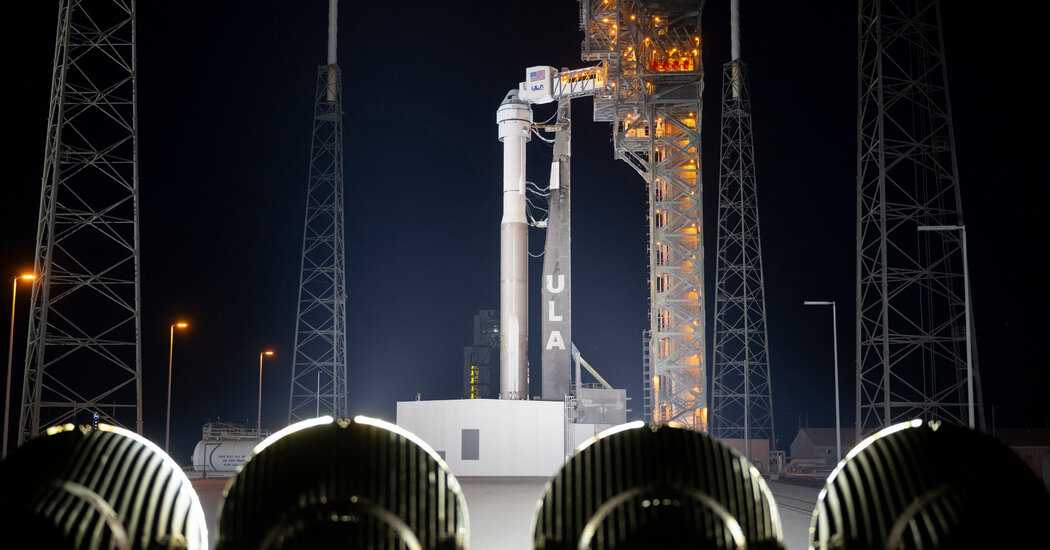NASA astronauts will have to wait until at least the end of next week to launch to orbit in the Boeing Starliner spacecraft. The planned launch was called off Monday night because of a problem in the Atlas V rocket that was to send them to space.
On Tuesday night, NASA announced that the two astronauts, Butch Wilmore and Suni Williams, would remain on the ground until May 17 at the earliest. Earlier in the day, the agency had said a launch later this week, perhaps on Friday, might be possible.
United Launch Alliance, the maker of the Atlas V, said the rocket would be rolled back from the launchpad to replace a valve that regulates pressure in the oxygen tank in the second stage.
That further postponed the first-ever crewed flight of Starliner, a ride for NASA astronauts to and from the International Space Space Station, which has experienced a series of costly delays over the past several years.
About three hours before the scheduled launch time of 10:34 p.m. Eastern time, just as the astronauts arrived at the launchpad, the valve started to buzz at a rate of about 40 times a second. Crews at the launchpad described hearing an “unusual audible” to flight controllers.
The flight preparations continued with Mr. Wilmore and Ms. Williams boarding the spacecraft. But at 8:34 p.m. Eastern time, two hours before the scheduled liftoff, United Launch Alliance, the company that builds and manages the rocket, called off the flight.
Tory Bruno, the chief executive of U.L.A., said this behavior had been observed previously during some other Atlas V launches, and opening and closing the valve typically stops the buzzing.
But for a launch of astronauts, U.L.A. had made a rule not to do anything that might change the status of the rocket when the astronauts were present, including opening and closing a valve. That was not by itself a dangerous action, but it still would have added uncertainty.
“Our philosophy is we don’t have to change the state of the vehicle when the people are there, so we won’t,” Mr. Bruno said in a Monday night news conference along with officials from NASA and Boeing.
After the astronauts exited Starliner and returned to their crew quarters, the valve was closed and the buzzing stopped. But the oscillations recurred twice as propellant was drained from tanks.
After reviewing the data, U.L.A.’s engineers concluded that the valve had exceeded the limit of the number of times it could be reliably opened and closed and that it needed to be replaced.
Boeing was one of two companies that won a contract to build a spacecraft to fly astronauts to and from the space station several years after NASA retired its space shuttles in 2011. For nine years, astronauts could get to the International Space Station only aboard Russia’s Soyuz rockets.
The other company was SpaceX. In May 2020, two NASA astronauts, Bob Behnken and Doug Hurley, flew to the I.S.S. in SpaceX’s Crew Dragon. That capsule has since become the only way to get to orbit from the United States.
The development of Starliner took Boeing far longer than it had expected. Technical pitfalls included inadequate software testing, corroded propellant valves, flammable tape and a key component in parachute system that turned out to be weaker than designed. Boeing fixed the problems, and it was finally ready to launch. The delays have left Boeing facing more than $1.4 billion in unexpected charges.
While Monday’s scrubbed flight was caused by the rocket, the postponed launch attempt comes during a tough 2024 for the aerospace giant. Just days into the year, a panel on the body of a Boeing 737 Max 9 blew off during an Alaska Airlines flight. The pilots were able to safely land the plane, and there were no major injuries, but the episode has had widespread repercussions for the company, particularly its aviation division.
Niraj Chokshi contributed reporting.


